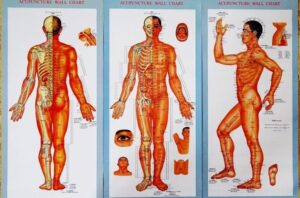The treatment of the body using chi has been around for a very long time. One of the first written accounts describing meridians as channels of energy was discovered in a Han dynasty (206BC – 220AD) tomb in Hunan, China; 8000 year old stone acupuncture needles have been found, also in China, and Neolithic ice mummies have been found to have acupuncture points tattooed on their skin. There is ample evidence therefore that people have been aware of chi, and been treating it for many, many years.
Acupuncturists will say that meridians were discovered as a result of needling specific points, and finding where the sensation goes to. I feel that it is just as likely that this stimulation was given using touch rather than penetration with a needle. In any event, traditional acupuncture training requires a long apprenticeship using touch alone before needles are introduced.
Whichever came first, touch or penetration, ordinary people, in what was a peasant agrarian society, would have not had the skill to practice acupuncture or the resources to hire skilled medical practitioners. This lead to the tradition of treating family and friends using manipulation of the meridians and popularly known points. We all know some of these points and use them instinctively – think what you do when you have a headache, eyestrain or indigestion, and then check the points!
As the dominant regional power, China exported many of its customs, sciences and technologies to adjacent countries, and similar manipulation techniques appeared in the Philippines, Indonesia, and even as far away as India, where the Vedic concept of Prana is very similar to that of Chi. It is worth noting that the Indian culture claims that this was a discovery that they made themselves and then exported East. If this is so it would underline the validity of the concept as it apparently arose in more than one place, and carried enough of a resonance to be widely accepted in both.
The story of Shiatsu as we now know it, however, carries on in Japan which in the 6th Century, like so many of its neighbours, adopted much of the Chinese view of medicine. The concept of chi (ki in Japanese) became as central to Japanese culture as it was in China. So much so that the equivalent greeting to ‘how are you?’ in English translates to ‘how is your ki?’ in Japanese, and the expression for poor health means literally ‘bad ki.’
The result was that ki manipulation in the form of Shi-atsu meaning ‘finger pressure’ became a great folk tradition in Japan, and for centuries it flourished as a part of everyday life. By the beginning of the last century, however, the gradual move towards Western scientific and medical values which were seen as modern and somehow more exciting had reduced Shiatsu’s importance. It had become something of an embarrassment, having the same connotations as Swedish massage would have had in the seventies and eighties- slightly seedy and a mode of pleasure rather than a medical procedure.
There was a rearguard action, however, headed by Tokujiro Namikoshi who founded the Clinic of Pressure Therapy in 1925. This school took on board Western nomenclature, and favoured a more ‘scientific’ approach. This enabled Shiatsu to continue in a clinical setting, and the Namikoshi style is still the most widely practiced in Japan.
What we see as Shiatsu in the West is derived from the Namikoshi school in that it was the son of a teacher that put together what became called Zen Shiatsu. Shizuto Masunaga, a professor of psychology at Tokyo University, inherited a deep interest in Traditional Chinese Medicine from his mother who was a teacher at the Namikoshi school for ten years.
During the 1970s, Masunaga combined his understanding of psychology with TCM and conventional Shiatsu as practiced by his mother, and created what he called Zen Shiatsu, a synthesis of modern Western thinking and traditional Eastern healing techniques. He took this to the United States where he continued to develop his theories up to his death in 1981.
Since then, his students and third and fourth generation Shiatsu practitioners have continued the development of Shiatsu building a vibrant and dynamically growing treatment system.
Shiatsu today has a multitude of styles and approaches; indeed each practitioner has their own individual style. Within this, though, there is a core structure underlying each treatment which has been evolving for 8000 years or more.
(Source: corespirit.com; November 6, 2016; http://tinyurl.com/gn8a3s3)
